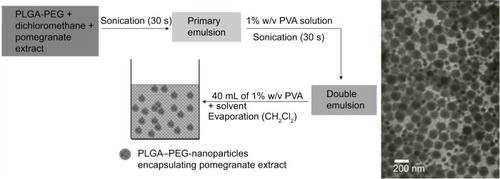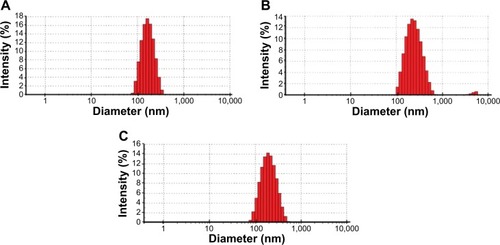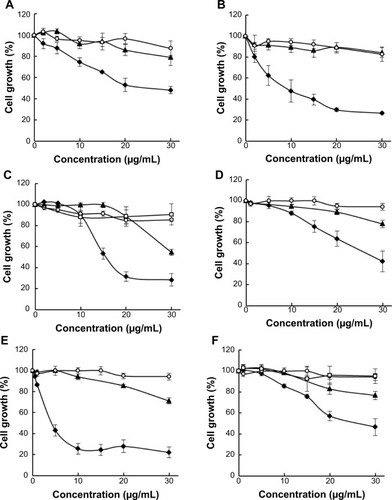Figures & data
Figure 1 The synthesis and TEM characterization of PLGA–PEG NPs encapsulating PE.
Abbreviations: PLGA–PEG, poly(lactic-co-glycolic acid)–poly(ethylene glycol); PVA, polyvinyl alcohol; NPs, nanoparticles; PE, pomegranate extract; TEM, transmission electron microscopy.

Table 1 Characterization of NPs by DLS
Figure 2 The size distribution of NPs. Representative histograms from DLS data of the size (diameter) distribution of PE-NPs (A), PU-NPs (B), and EA-NPs (C) are shown.
Abbreviations: PE, pomegranate extract; PU, punicalagin; EA, ellagic acid; NPs, nanoparticles; DLS, dynamic light scattering.

Figure 3 The intracellular uptake of NPs over a 24-hour time course.
Notes: MCF-7 cells were incubated with Alexa Fluor-488-labeled PLGA–PEG NPs for 15 minutes (A), 2 hours (B), 6 hours (C), and 24 hours (D). Confocal microscopy images were taken at 63× magnification and 5× optical zoom.
Abbreviations: NPs, nanoparticles; PLGA–PEG, poly(lactic-co-glycolic acid)–poly(ethylene glycol).

Figure 4 The effect of pomegranate nanoprototypes on MCF-7 and Hs578T breast cancer cell growth.
Notes: MCF-7 cells were treated with PE-NPs (A), PU-NPs (B), and EA-NPs (C) versus their respective free counterparts. Hs578T cells were treated with PE-NPs (D), PU-NPs (E), and EA-NPs (F) versus their respective free counterparts. Solid diamonds show pomegranate phytochemical loaded NPs, solid triangles show respective free counterparts, open circles depict void NPs and open rectangles show NaOH solvent control for EA. Cells were treated for 96 hours; n=3 experiments; error bars depict SEM.
Abbreviations: PE, pomegranate extract; PU, punicalagin; EA, ellagic acid; NPs, nanoparticles; SEM, standard error of the mean.

Table 2 IC50 of pomegranate nanoprototypes and their free counterparts in MCF-7 and Hs578T cells

